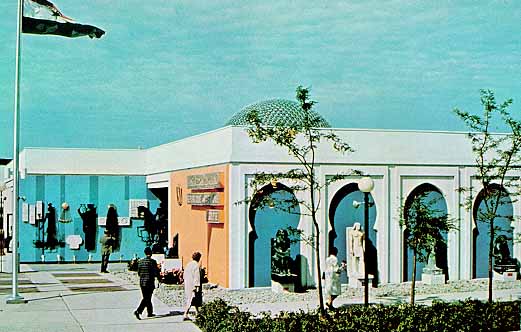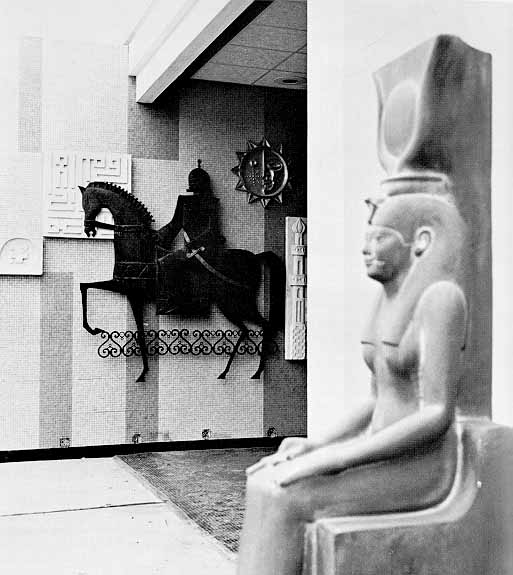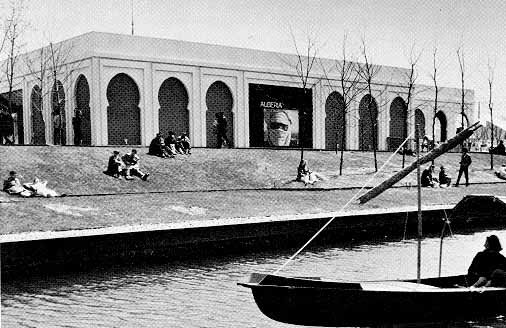Arab Pavilions
The Arab Pavilions complex featured pavilions of Algeria, Kuwait and the United Arab Republic (Egypt).United Arab Republic
Inside the United Arab Republic's pavilion the visitor could see replicas of Tutankhamen's golden mask, his small throne and other pieces of furniture discovered in 1923 inside the young Pharaoh's tomb.
| The United Arab Republic pavilion |
Another section of the pavilion was devoted to iron and steel, the foundation of the UAR's industrialization. Photographs and maps showed the Helwan steel complex, the Aswan dam and the locations of 703 factories established between 1952 and 1964. Heavy machinery, motors, television sets, firearms and hundreds of other industrial products demonstrated its industrial progress.
Other exhibits showed the UAR's social progress in the fields of education and housing. The country offered a free education system at all levels. They also showed models that compared an old Egyptian house with its rooms opening into an inner courtyard, with that of a mass-produced modern designed for the poorer populace.
 |
Egyptian antiquities inside the UAR pavilion. |
Outside, near the entrance, five figures in a sculptured panel evoked the main landmarks of the country's development from the time of the Pharaohs through successive Roman, Christian and Islamic eras. In the gardens around the pavilion, Moorish architectural arcades, offered replica of some of the most famous Theban sculptures.
Algeria
The Algerian pavilion's exterior was faced with marble and blue tile. Inside among its airy main hall and numerous arcades, the visitor was introduced to both current and ancient facets of Algerian history. Shown on twelve screens were color slides and films of the country's archaeological digs, its expansion of petroleum and natural gas industries, the fight against illiteracy, and the development of agriculture and technology.
| The Algeria Pavilion. |
A splendid collection of art objects illustrated the country's history. Relics of ancient civilizations showed the link between eastern Algeria and Egypt 5000 years ago. Perfume vases, urns, necklaces and bronze statuettes revealed a secular Oriental tradition influenced by Greece and Rome. Their were photographs and moldings of ancient Numidian ruins when the peasants went to war against Rome in the days of Roman Algeria.
Another section shows Muslim Algeria with objects dating back to the 17th and 18th centuries. The displays, which depicted what it was like to live in those times, even featured delicately ornamented musical instruments like the lute. Also on display was the paraphernalia of the Algerian horseman, the warriors of legendary prowess. There were pistols, gems, swords and scabbards, all finely engraved with silver inscriptions or damascene work.
At the end of the pavilion was a typical restaurant that offered specialties of the country; couscous accompanied by a heady Algerian wine, and including light, succulent pastries flavored with honey or cinnamon.
Kuwait
Kuwait's pavilion was a simple replica of a Moorish building, very similar in design to that of the United Arab Republic and Algeria. Inside photographs and models showed the impact of oil on the desert country. There was a model of a desalinization plant in operation.But on the morning of May 29th, as a result of a tense Middle East situation, the doors were locked. Two weeks later all exhibits were removed and Kuwait became the only country to come to Expo 67 and leave before the end.